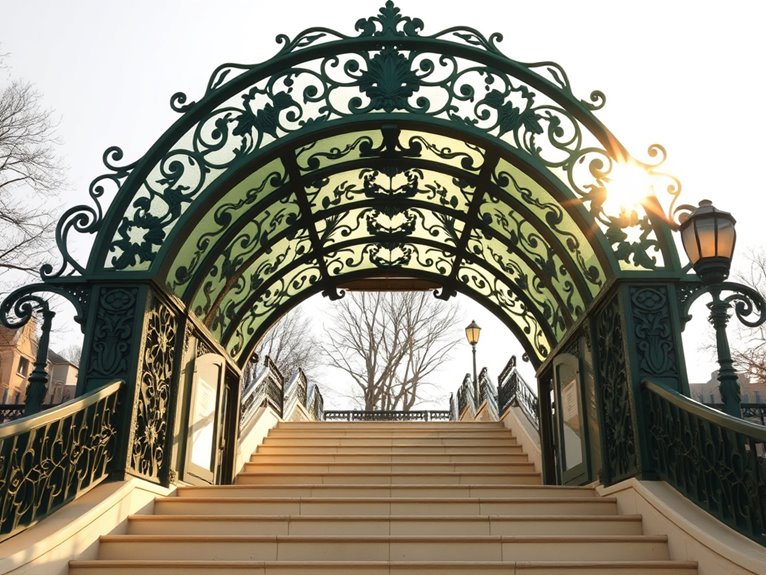
7 Most Beautiful Metro Entrances in Paris
Paris's most enchanting metro entrances showcase the city's artistic soul! From Abbesses Station's iconic Art Nouveau ironwork to the modern glass-bead crowns at Palais Royal-Louvre, you'll find architectural treasures underground. Don't miss Cité's Belle Époque grandeur, Saint-Michel's Gothic revival, Porte Dauphine's Guimard masterpiece, Arts Et Métiers' steampunk wonderland, or Bastille's revolutionary spirit. Each entrance tells a unique story of Parisian innovation – let's explore these magnificent gateways together!
Abbesses Station: Art Nouveau's Crown Jewel
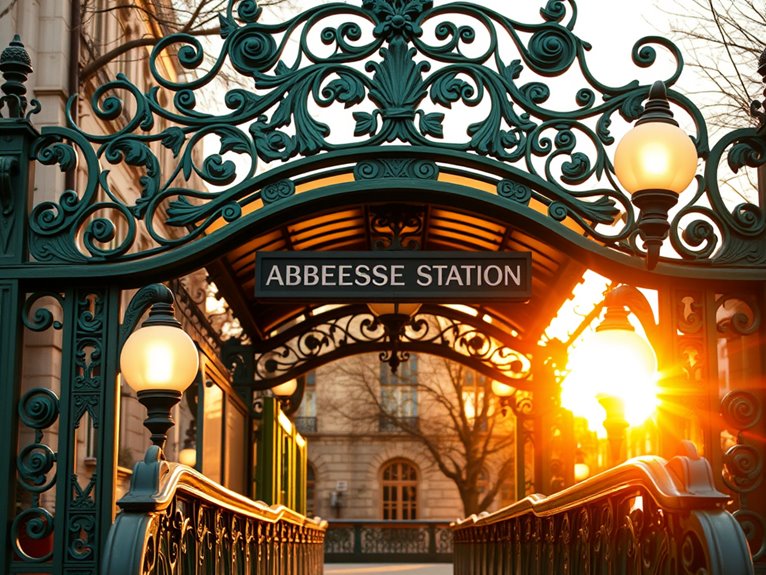
Nestled in the heart of Montmartre, Abbesses metro station stands as one of Paris's most photographed and architecturally significant metro entrances. Designed by Hector Guimard in 1900, this striking Art Nouveau entrance epitomizes the artistic movement that swept through Paris at the turn of the 20th century, with its distinctive green-hued cast iron structure and elegant whiplash curves that mimic organic forms.
The station's entrance, one of only two original glass-covered "dragonfly" designs remaining in Paris, represents more than just a transit point—it's a reflection of the city's commitment to making everyday infrastructure beautiful. While most of Guimard's original metro entrances have disappeared over time, Abbesses stands as a perfectly preserved example of how public architecture can elevate the mundane into the extraordinary.
Quick Facts:
- Best visiting hours: Early morning (6-8 AM) or late evening (9-10 PM) for fewer tourists
- Photography conditions: Best during golden hour or after rain when the iron gleams
- Depth: Deepest station in Paris (36 meters underground)
- Access: Metro Line 12
- Nearby attractions: Sacré-Cœur, Place du Tertre, Montmartre vineyards
- Historical significance: Listed as a historical monument since 1978
The Architectural Marvel
The entrance features intricate plant-inspired metalwork, with tendrils and stems wrapping around red glass globes that originally illuminated the entrance. The iconic "Métropolitain" sign, written in Guimard's distinctive typography, crowns the structure. The station's original elements remain largely intact, making it one of the most authentic examples of Art Nouveau metro design in existence.
The Underground Journey
Despite its beautiful entrance, many visitors don't realize that Abbesses is one of Paris's deepest stations. The spiral staircase, decorated with vibrant murals depicting local life and love stories, creates an artistic journey downward. Insider tip: Take the elevator down but walk up at least part of the way to appreciate the murals—they're often missed by hurried commuters.
Pro Tips
For photography enthusiasts, visit during early morning hours when the rising sun creates dramatic shadows through the ironwork, or after rainfall when the wet metal takes on a deeper green patina. Position yourself at the corner of rue des Abbesses and rue Ravignan for the best architectural shots that capture both the entrance's detail and its context within Montmartre's charming streetscape.
Practical Advice
While the station's beauty makes it a must-visit destination, remember it's an active metro station serving thousands of commuters daily. Visit during off-peak hours to fully appreciate the architecture without disrupting local traffic. Keep your metro ticket handy—the station's depth means you'll need it to access both elevators and turnstiles. For those with mobility concerns, note that while elevators are available, they can be slow during peak hours, and the spiral staircase, though beautiful, requires significant physical effort.
Palais Royal-Musée Du Louvre: the Kiosque Des Noctambules
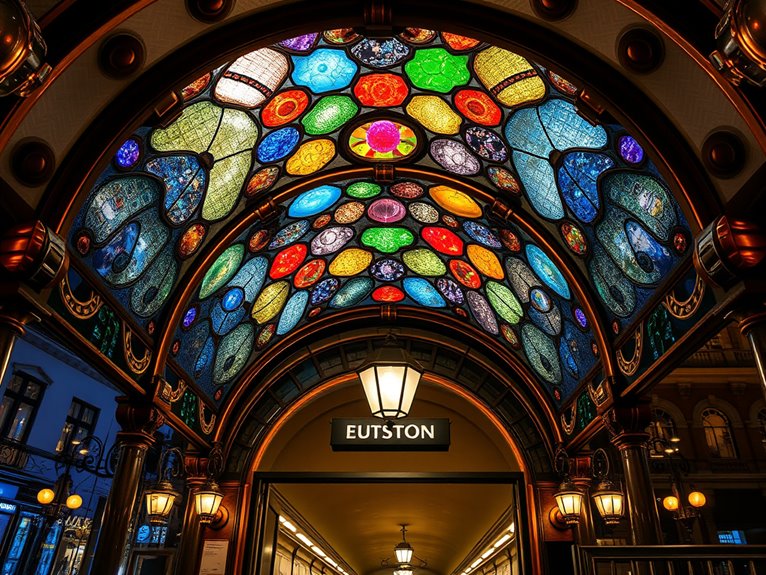
The Palais Royal-Musée du Louvre metro entrance stands as one of Paris's most striking architectural achievements, where contemporary art meets public transportation. Created by French artist Jean-Michel Othoniel in 2000 to commemorate the Paris Métro's centennial, this remarkable entrance features two dramatic crown-like structures made of colorful Murano glass beads strung on graceful aluminum ribbons.
This artistic metro entrance transforms the mundane act of entering the subway into a magical experience, with its intricate design representing the journey between day and night. The structure's name, "Kiosque des Noctambules" (Kiosk of the Night Walkers), perfectly captures its ethereal quality and the way it serves both practical and artistic purposes in one of Paris's most culturally significant neighborhoods.
Quick Facts:
- Best viewing times: Dawn and dusk for best lighting
- Location: Place Colette, 1st arrondissement
- Photography permitted: Yes, no tripods during peak hours
- Access: Free to view from exterior
- Metro lines: 1, 7, 14
- Busiest times: 9-11 AM and 4-6 PM weekdays
- Best photo angles: From the plaza benches facing the Comédie-Française
The Installation's Design
The structure consists of two crown-like domes, each measuring six meters in height, crafted from strings of oversized glass beads in hues of amber, ruby, and crystal. The northern dome represents day, while the southern dome symbolizes night, creating a poetic narrative about the passage of time and the continuous flow of urban life. The entrance is particularly stunning when illuminated at night, as the glass beads catch and reflect light in mesmerizing patterns.
Pro Tips:
Visit during the "blue hour" just after sunset when the artificial lighting creates a perfect balance with the remaining natural light, making the glass beads appear to glow from within. Professional photographers often time their visits to coincide with wet weather, as the reflective surfaces of the glass beads create stunning effects when combined with rain-slicked pavements.
Practical Considerations:
The entrance is located in a busy area near the Louvre and Palais Royal, so plan your visit outside of rush hours for the best experience. The surrounding Place Colette offers several cafes where you can sit and admire the structure while enjoying a coffee. While the entrance is a functioning metro station, it's worth noting that the area immediately around the installation can get crowded with photographers and tourists, so patience may be required to capture the perfect shot or to simply appreciate its beauty unobstructed.
Cité Station: Belle Époque Grandeur
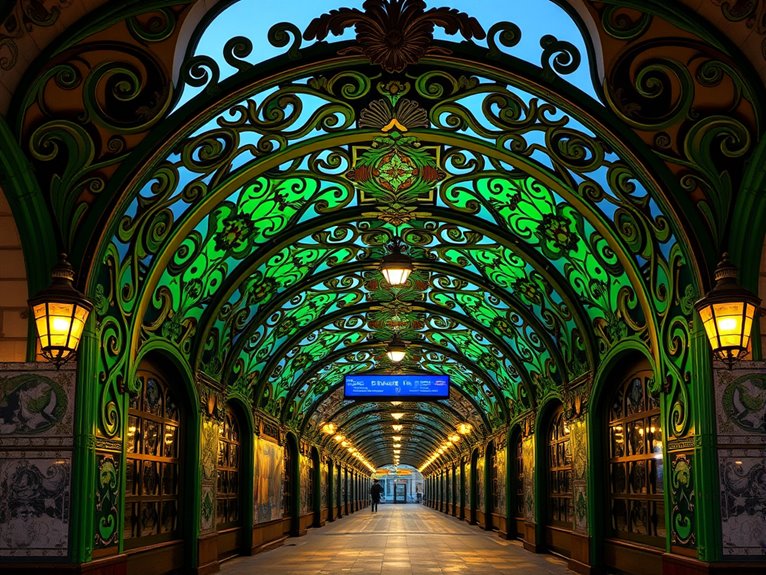
Located on the historic Île de la Cité, the Cité Metro Station entrance stands as one of Paris's most spectacular examples of Art Nouveau architecture and Belle Époque design. Created by architect Hector Guimard in 1900, this entrance has become an iconic symbol of Parisian metropolitan artistry, featuring distinctive whiplash curves, organic forms, and elegant iron latticework that epitomizes the artistic movement of its era.
The station's entrance serves Line 4 of the Paris Métro and offers visitors more than just a transit point – it's a portal to understanding Paris's commitment to making even functional infrastructure aesthetically magnificent. The red lamp posts, emerald-green railings, and ornate "Métropolitain" signage combine to create a striking visual landmark that has inspired photographers, artists, and architects for over a century.
Quick Facts:
- Best viewing times: Early morning (6-8 AM) or late evening (9-11 PM) for ideal lighting
- Photography permitted: Yes, no flash needed during daylight
- Access: Free to view exterior; metro ticket required for entry
- Peak tourist times: 10 AM – 4 PM
- Notable features: Original Art Nouveau ironwork, period-authentic lighting
- Conservation status: Protected historical monument since 1978
The Architectural Marvel:
The entrance pavilion showcases Guimard's signature style through its plant-inspired motifs and flowing lines. The structure rises from the ground like an organic growth, with cast iron tendrils supporting a glass canopy that seems to float above passengers. The station's location at 2 Place Louis Lépine positions it perfectly against the backdrop of historic Paris, creating a stunning juxtaposition of medieval and turn-of-the-century design. Insider tip: Look for the original maker's mark on the iron supports – they bear Guimard's signature and the foundry date.
Pro Tips:
For the most atmospheric experience, visit at dusk when the original-style globe lamps illuminate and cast a warm glow over the iron lattice work. Photographers should position themselves on the northwest corner of the square to capture both the entrance and Notre-Dame Cathedral in the background. During summer months, the morning light between 7-8 AM provides ideal conditions for capturing the intricate details of the ironwork without harsh shadows.
Practical Advice:
While the exterior is always accessible for viewing and photography, visitors should be mindful of commuter traffic during rush hours (8-9:30 AM and 5-6:30 PM). The area can get crowded with tourists, so consider visiting during off-peak hours. For those interested in photographing the interior, a metro ticket is required, and tripods are generally not permitted without prior authorization from RATP (Paris's transit authority).
Saint-Michel: Gothic Revival Gateway
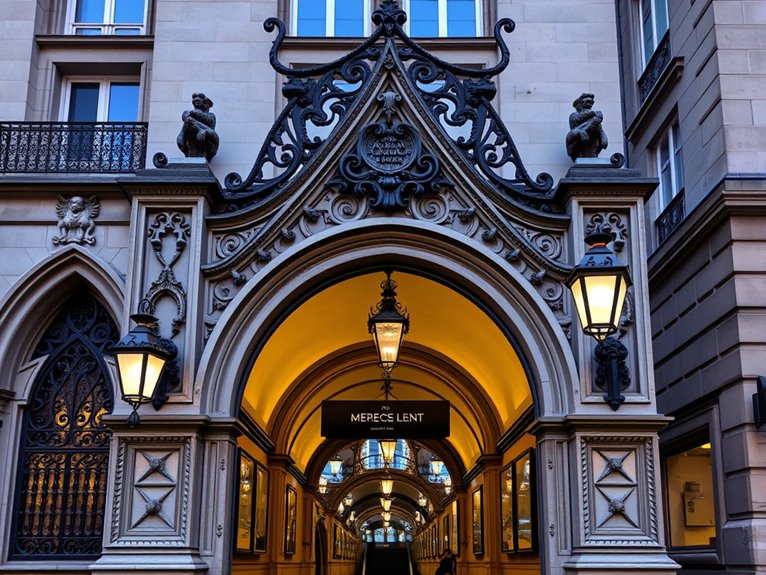
The Saint-Michel Metro entrance stands as one of Paris's most striking examples of Gothic Revival architecture in public transit design, seamlessly blending 19th-century artistic grandeur with daily urban functionality. Located in the heart of the Latin Quarter, this entrance serves as both a practical access point to the city's underground transportation system and a magnificent architectural monument that reflects Paris's commitment to making even routine infrastructure aesthetically pleasing.
This particular entrance, designed to complement the medieval character of the surrounding neighborhood, features intricate stone carving, pointed arches, and decorative ironwork that transforms an ordinary metro station into a miniature cathedral of urban transport. The structure's elaborate details and historical significance make it a popular spot for photography enthusiasts and architecture aficionados alike.
Quick Facts:
- Best viewing times: Early morning (6-8 AM) or evening (7-9 PM) for ideal lighting
- Photography permitted: Yes, without tripods
- Location: Place Saint-Michel, 5th arrondissement
- Metro lines: 4 and RER B and C
- Access: 24/7 exterior viewing; station hours 5:30 AM – 1:15 AM
- Crowd levels: Moderate to heavy throughout day
- Best photo angles: From the fountain side or diagonal across the square
The Gateway Experience
The Saint-Michel entrance distinguishes itself through its imposing stone archway, featuring delicate tracery and ornamental spires that rise several meters above street level. The entrance's design deliberately mirrors elements from Notre-Dame Cathedral, creating a visual dialogue between Paris's sacred and civic architecture. Station access is available through both sides of the structure, with the original cast-iron handrails still in use. Insider tip: Look for the subtle mason's marks carved into the lower stones – these authentic signatures from the original craftsmen are often overlooked by visitors.
Pro Tips
Time your visit to coincide with the golden hour just before sunset when the warm light brings out the honey tones in the limestone and creates dramatic shadows among the Gothic details. Street performers often gather in the square, providing an opportunity to capture the entrance with live entertainment in the foreground. Consider visiting during light rain, when the wet stones enhance the dramatic appearance of the carved details.
Practical Considerations
To fully appreciate the entrance while avoiding the largest crowds, visit on weekday mornings or during winter months. Photography is unrestricted, but be mindful of commuter traffic during rush hours (8-10 AM and 5-7 PM). The surrounding area offers numerous cafes and viewing spots from which to admire and photograph the structure. Keep your belongings secure, as the busy square can attract pickpockets, and consider purchasing a metro ticket to explore the station's equally impressive interior details.
Porte Dauphine: Guimard's Masterpiece
Beautiful Metro Entrances in Paris: Porte Dauphine
——————-
The Porte Dauphine metro entrance stands as the crown jewel of Art Nouveau design in Paris's underground transportation system. Created by acclaimed architect Hector Guimard in 1900, this entrance is one of only two remaining original covered "dragonfly" designs, featuring a stunning glass canopy supported by elegant cast iron structures that resemble organic, flowing forms.
Located in the prestigious 16th arrondissement, this architectural masterpiece represents the golden age of Parisian metro design and serves as a representation of the city's commitment to making even functional spaces beautiful. The entrance's intricate details, from its signature green-hued ironwork to the distinctive "Métropolitain" lettering, make it a must-visit destination for architecture enthusiasts and photographers alike.
Quick Facts:
- Best viewing times: Early morning (7-9 AM) or late afternoon (4-6 PM) for ideal lighting
- Photography permitted: Yes, no tripods allowed during peak hours
- Access: Free to view from exterior
- Metro Line: Line 2
- Conservation status: Historical Monument since 1978
- Best photo angle: From the small plaza across the street
- Lighting: Most dramatic at dusk when interior lights activate
The Structural Marvel:
The entrance pavilion features a distinctive double-sided design with a deep green cast iron framework supporting an elegant glass canopy. The structure rises approximately 4 meters high and spans 9 meters in width, creating a graceful shelter that protects passengers while serving as a visual feast. Insider tip: Look for the subtle differences between the two sides of the entrance – the western face features slightly more ornate details in its ironwork.
Location and Access:
Situated at Place du Maréchal de Lattre de Tassigny, the entrance serves the Porte Dauphine station on Line 2. The station operates from 5:30 AM to 1:15 AM daily. While the entrance itself is freely accessible to view, consider purchasing a metro ticket to experience the restored interior elements. Lesser-known fact: The original ticket booth inside remains intact and features unique period details not found at other stations.
Pro Tips:
For photographers, early Sunday mornings provide the best opportunity to capture the entrance without crowds or vehicles obstructing the view. The low morning light creates dramatic shadows through the glass canopy, highlighting Guimard's intricate ironwork patterns. During winter months, the late afternoon golden hour (around 4 PM) offers particularly striking lighting conditions as the sun's rays filter through the western-facing glass panels.
Practical Advice:
When visiting Porte Dauphine, combine your metro entrance viewing with a walk through the adjacent Bois de Boulogne or the nearby upscale residential areas of the 16th arrondissement. The station can get busy during rush hours (8-10 AM and 5-7 PM), so plan your visit outside these times for a more relaxed experience. Bring a wide-angle lens for photography, and consider visiting on a cloudy day when the diffused light reduces harsh shadows and glare on the glass canopy.
Arts Et Métiers: Steampunk Underground
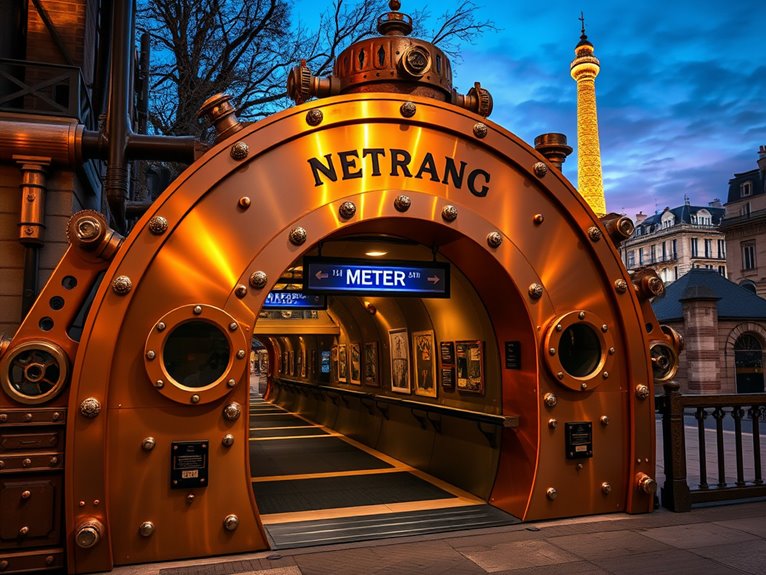
Beautiful Metro Entrances in Paris: Arts Et Métiers Station
Steampunk Underground
Descending into Arts Et Métiers metro station feels like stepping into a Jules Verne novel come to life. This extraordinary station, redesigned in 1994 by Belgian artist François Schuiten, transforms the everyday Paris metro experience into an immersive journey through industrial fantasy, with its copper-clad walls and submarine-like aesthetics paying homage to the nearby Musée des Arts et Métiers (Museum of Arts and Crafts).
The station's unique design celebrates both French scientific history and steampunk aesthetics, creating one of Paris's most photographed metro stations. Every detail, from the oversized gears mounted on the walls to the porthole-style lighting fixtures, contributes to an atmospheric underground experience that makes even a brief transit stop feel like an artistic adventure.
Quick Facts:
- Best visiting times: 10:00-16:00 (weekdays for fewer crowds)
- Photography permitted without flash or tripod
- Access with standard metro ticket (€1.90)
- Located in the 3rd arrondissement
- Platform accessible via Lines 3 and 11
- Station remains open from 5:30 AM to 1:15 AM
The Steampunk Experience:
The platform of Line 11 showcases the most dramatic transformation, completely encased in copper-colored metal plates that evoke the interior of a Victorian-era submarine or airship. Massive rivets line the walls, while giant cogs and mechanical components appear to emerge from the surfaces. The design directly references the collections of the Arts et Métiers museum above ground, creating a thematic connection between the station and its namesake institution. Most visitors miss the subtle detail that the copper panels are actually painted concrete, masterfully crafted to create the illusion of metal.
Pro Tips:
For the best photography opportunities, visit during off-peak hours, particularly mid-morning on weekdays. The copper surfaces reflect light beautifully, but timing is vital to avoid the blur of rushing commuters. Position yourself at the far end of the platform where the curve of the tunnel creates a striking vanishing point effect, particularly popular with photographers and social media enthusiasts.
Practical Advice:
While the station is fascinating, it's important to remember it's an active metro station. Stay aware of your surroundings and avoid blocking passenger flow while taking photos. Consider combining your visit with a trip to the Arts et Métiers museum above ground, as the station's design elements directly reference many exhibits in the museum's collection. The station can be accessed from multiple entrances, but the Rue Réaumur entrance offers the most dramatic first impression of the steampunk aesthetics.
Bastille: Revolutionary Design Heritage
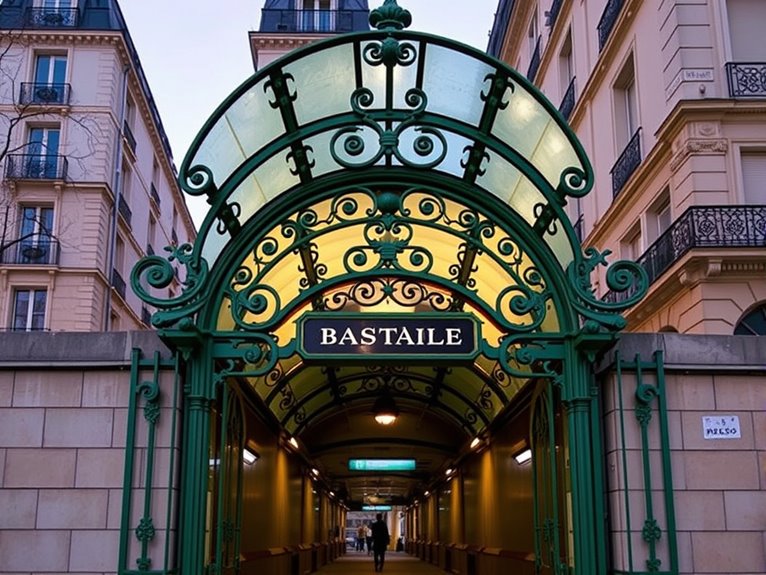
The Bastille metro station entrance stands as a tribute to Paris's commitment to blending historical significance with architectural innovation. Located in the heart of the historic Place de la Bastille, this metro entrance pays homage to the French Revolution while showcasing the distinctive Art Nouveau style that made Paris metro stations world-famous.
This particular entrance, designed during the city's architectural renaissance of the early 20th century, features elements that directly reference the area's revolutionary past. The intricate ironwork incorporates symbols of liberty and revolution, while the overall structure maintains the elegant curves and natural motifs characteristic of Hector Guimard's iconic metro designs.
Quick Facts:
- Best visiting hours: Early morning (7-9 AM) or late afternoon (4-6 PM) for ideal lighting
- Photography permitted: Yes, no flash needed
- Access: Lines 1, 5, and 8
- Historical significance: Built on the site of the former Bastille prison
- Restoration status: Regular maintenance preserves original elements
- Lighting: Particularly dramatic at dusk
The Bastille entrance's most striking feature is its cast iron archway, decorated with the signature "Metropolitan" lettering in Guimard's distinctive typography. The green-painted metalwork creates an organic frame that seems to grow from the ground, incorporating stylized flower stems and leaf patterns. This entrance serves not only as a functional portal to the metro system but as a historical marker, situated precisely where the notorious prison's foundations once stood.
Pro Tips:
Visit during July, particularly around Bastille Day (July 14), when the area comes alive with celebrations and the entrance is often decorated with traditional French flags and revolutionary symbols. For photographers, the morning golden hour provides ideal lighting conditions for capturing the intricate details of the ironwork, while evening shots can capture the entrance illuminated against the historic square's backdrop.
Practical Considerations:
While the entrance is accessible year-round, visitors should note that the area can become extremely crowded during major events and demonstrations, as Place de la Bastille remains a popular gathering point for political rallies. The station sees heavy foot traffic during rush hours (8:30-9:30 AM and 5:30-6:30 PM), so plan accordingly for unobstructed views and photographs. The nearest visitor information center is located within the Opera Bastille, where detailed historical maps and guides are available.
